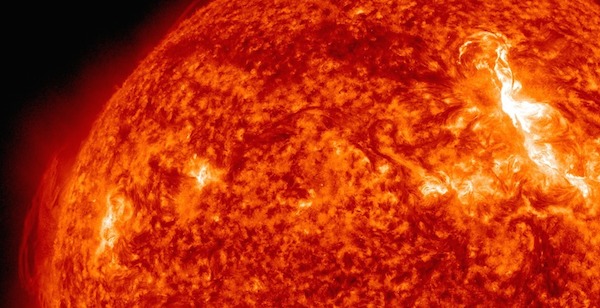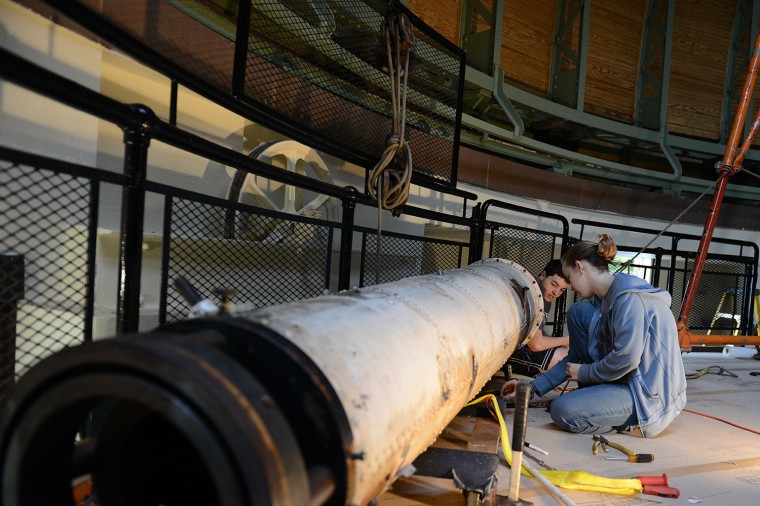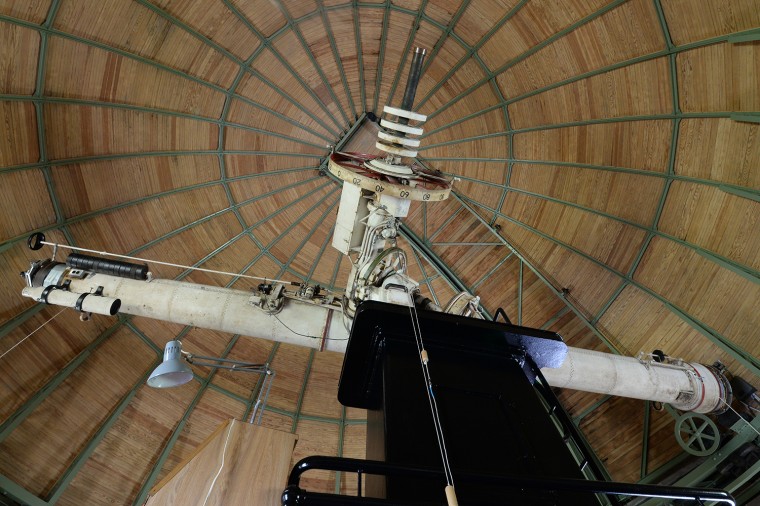A July NASA report that a huge solar storm narrowly missed Earth in 2012 – avoiding catastrophic damage to energy, transportation and communications systems – has caused a media stir and some worry among Earthlings. What’s more, other recent reports say that Earth is overdue for a devastating storm of the kind known as a “Carrington event” after an 1859 storm that disrupted telegraph signals and caused other damage in a still-nascent industrial world. Named for 19th-century English astronomer Richard Carrington, it was the largest of its kind on record. A similar event now, in a world dependent on digital…
The almost-century-old 20-inch Van Vleck Refractor, which lives on Foss Hill in its iconic dome, is undergoing a major renovation. Work began June 2. The rare historic telescope will be dismantled, cleaned, repaired, reassembled and modernized over a period of about 15 months in preparation of the observatory centennial in 2016. The refractor has been deteriorating gradually since its retirement from research around 1993. Antique Telescope Society members and Ray Museum Studios founders Fred Orthlieb, Ph.D. and Chris Ray are leading the renovation. Astronomy major Julian Dann '17 and German Studies major Rebecca Hanschell '16 are assisting with the project this summer. Read…
Nicole Arulanantham, who is entering her second year as a graduate student in the Astronomy MA program, was awarded a Chambliss Medal by the American Astronomical Society at its June 3 meeting in Boston. The awards are given to recognize exemplary research by a student presenting a poster paper at an AAS meeting. Arulanantham worked on the study with her advisor, Bill Herbst, the John Monroe Van Vleck Professor of Astronomy, chair of the Astronomy Department, and Ann Marie Cody of the California Institute of Technology. It involved analysis of data obtained with the Spitzer Space Telescope. Read more about the…
Beginning June 2, the nearly century-old 20-inch Van Vleck Refractor, which lives on Foss Hill in its iconic dome, will get a complete facelift to return it to full working order. The rare historic telescope will be dismantled, cleaned, repaired, reassembled and modernized over a period of about 15 months in preparation of the observatory centennial in 2016. (View several photos of the renovation here.) The work will be done by Fred Orthlieb, Ph.D. and Chris Ray, members of the Antique Telescope Society who run a company called Ray Museum Studios. Based in Swarthmore, Penn., they are well-regarded experts in…
Biology Ph.D candidate Sarah Kopac was invited to speak at the 2014 Spring Symposium of the Space Telescope Science Institute on the campus of Johns Hopkins University in Baltimore, M.D. on April 29. Kopac spoke on "Specialization of Bacillus in the Geochemcially Challenged Environment of Death Valley." Watch a video of her 20 minute presentation online here. Kopac's talk was part of a four-day interdisciplinary meeting titled "Habitable Worlds Across Time and Space" featuring speakers from around the world working in such diverse fields as biology, geology and astronomy. The focus of the seminar was on identifying places within our…
Meredith Hughes, assistant professor of astronomy, received a grant from the National Science Foundation to support her research on "Dust and Gas in Debris Disks Reveal the Origins of Planetary Systems." The grant, awarded on April 21, is worth $532,943. Hughes’ research focuses on understanding the formation and evolution of planetary systems. She particularly studies the huge disks of gas and dust surrounding a young star, which can give insight into how and when a star planet might form. The disk is made up of “junk” left over from the star’s formation. The main technique Hughes uses to observe these circumstellar…
With his Wesleyan undergraduate and graduate students, Assistant Professor of Astronomy Seth Redfield studies exoplanets, the local interstellar medium, and stellar and exoplanetary atmospheres. He talks about the unique opportunity offered through his exoplanet program at Wesleyan, in which students at the undergraduate level participate in cutting-edge research. [youtube]http://youtu.be/PNP5Cgc10go[/youtube] #THISISWHY
Bill Herbst, the John Monroe Van Vleck Professor of Astronomy, director of graduate studies, received a $5,000 grant from NASA's Jet Propulsion Laboratory to support observations with the Spitzer Space Telescope. The title of the proposal is “Planet Formation in the Circumbinary Disk of KH 15D.” Herbst and his colleagues are measuring the brightness of the T Tauri binary system KH 15D covering several important missing orbital phases around minimum light and one near maximum. Data is crucial to understanding the mechanisms behind the observed reddening in the system, which has implications for planetformation and disk evolution. Learn more about this study online here.
Meredith Hughes, assistant professor of astronomy, is the co-author of a paper titled "Molecular Gas Clumps from the Destruction of Icy Bodies in the β Pictoris Debris Disk," published in the journal Science on March 6. Read more about Hughes study in this Wesleyan Connection article.
A curious mix of dust and gas surrounding a distant star presents a unique mystery – and possibly a front-row seat to planet formation, according to Assistant Professor of Astronomy Meredith Hughes and colleagues, whose paper on the star appears in the March 6 edition of the journal Science. The group of astronomers, including Hughes and 13 others, were the first to identify the asymmetry and “lumpy” quality of the gas surrounding beta Pictoris, using data from the Atacama Large Millimeter/Submillimeter Array (ALMA) in Chile. The discovery leads to two possible explanations: There may be a giant "exoplanet" lurking nearby…
Taft Armandroff ’82 has been appointed as director of the University of Texas at Austin’s McDonald Observatory in Fort Davis, Texas. He’ll be moving to the Lone Star State in June 2014 to claim his new position. Armandroff’s specialties include dwarf spheroidal galaxies, stellar populations in the Milky Way and nearby galaxies, and globular clusters. He will soon be leaving his current position as director of the W.M. Keck Observatory in Mauna Kea, Hawaii. Prior to Keck, he worked for 19 years at the National Optical Astronomy Observatory (NOAO) in Tucson, Ariz., having earned his BA in astronomy with honors…
Seth Redfield, assistant professor of astronomy, spoke with Patrick Skahill and WNPR News on Nov. 15 about the sun flipping its magnetic polarity, which only happens every 11 years. While the change in polarity is not fully understood by scientists, the event is exciting “because this is kind of a probe into the internal workings of the sun, which is actually really hard for us to get a handle on,” according to Redfield. This solar cycle, Cycle 24, has not been disruptive to satellites or the electric grid, which can react negatively to solar radiation. The sun’s northern hemisphere flipped…




